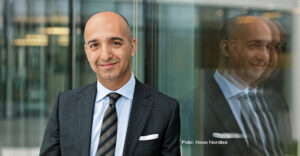Resume af teksten:
Den tyske økonomi er faldet tilbage i recession i andet kvartal med en nedgang på 0,1% i BNP, efter en vækst på 0,4% i første kvartal. De nye data viser, at investeringer har tynget økonomien, mens forbrug er steget en smule. Trods tidligere optimisme, som skyldtes en stigning i eksporten, er det nu tydeligt, at den positive effekt er aftaget, og US-told har haft sin fulde virkning. Fremtiden for den tyske økonomi er usikker med udfordringer fra handelsrestriktioner og en stærkere euro. Eksporten forventes ikke at kunne drive væksten igen snart, og økonomien satser i stedet på finanspolitik og innovation. Optimisme alene er ikke nok til at bringe stærk vækst tilbage.
Fra ING:
With a reversal of the positive frontloading effects, the German economy fell back into recessionary territory in the second quarter. The return to growth and a strong economy remains a long and complicated project

Tourists at The Reichstag in Berlin
Can we measure a gap between hard and soft economic data, between optimism and tough reality? Yes, we can. In Germany, it’s -0.1%. This is the just-released first estimate of German GDP growth in the second quarter. After a surge of 0.4% Q-o-Q in the first quarter, the German economy shrank by 0.1% in the second. On the year, the economy grew by 0.4%, seasonally and calendar adjusted. According to the statistical agency’s press release, investments were a drag on the economy, while private and public consumption increased a little.
Optimism alone doesn’t bring back growth
Today’s GDP data show that the recent wave of optimism that had caught the German economy is not yet showing in the data. In fact, after the surge in economic activity as a result of US frontloading of German exports in the first quarter, the economy now experienced a reversal of the frontloading effect and the first full-blown impact of the US tariffs actually implemented in the second quarter.
Looking ahead, the path for the German economy will be highly affected by trade, the exchange rate and fiscal stimulus. In the near term, recent corporate results were already a painful reminder that US tariffs, but also structural transitions, were already in full swing in the second quarter, weighing on company results. A trend that will hardly change in the third quarter. Even if there is some clarity now on what many have called a trade deal between the US and the EU, there are still many things that could go wrong, bringing back tariff escalation. In any case, at 15%, US tariffs should dent some 0.1-0.2pp of German GDP growth. Add to that the stronger euro exchange rate, not only vis-à-vis the US dollar but many other currencies, and it looks highly unlikely that exports could soon again be a significant growth driver for the German economy, which puts all hopes on fiscal stimulus, corporate investments and innovation to bring back growth.
All in all, despite the recent optimism, today’s GDP data is a painful reminder that optimism alone does not automatically bring back strong growth. The economy’s flirtation with yet another year of stagnation continues.
Hurtige nyheder er stadig i beta-fasen, og fejl kan derfor forekomme.



